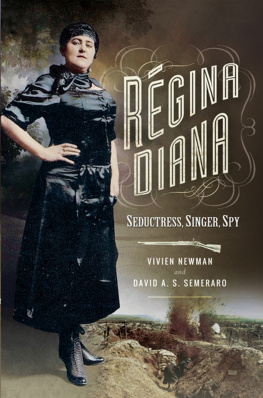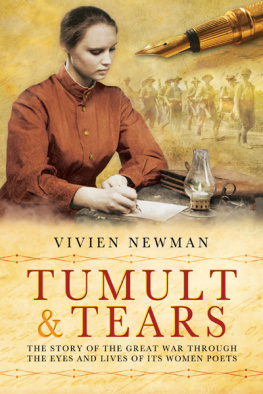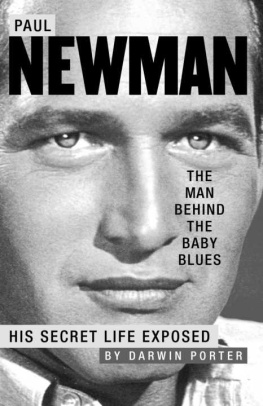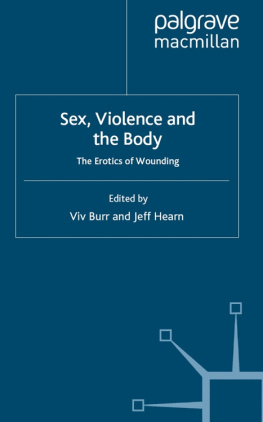Suffragism and the Great War
Suffragism and the Great War
Vivien Newman
First published in Great Britain in 2018 by
PEN & SWORD MILITARY
An imprint of
Pen & Sword Books Ltd
Yorkshire - Philadelphia
Copyright Vivien Newman, 2018
ISBN 978 1 52671 897 6
eISBN 978 1 52671 899 0
Mobi ISBN 978 1 52671 898 3
The right of Vivien Newman to be identified as Author of this work has been asserted by him in accordance with the Copyright, Designs and Patents Act 1988.
A CIP catalogue record for this book is available from the British Library
All rights reserved. No part of this book may be reproduced or transmitted in any form or by any means, electronic or mechanical including photocopying, recording or by any information storage and retrieval system, without permission from the Publisher in writing.
Pen & Sword Books Ltd incorporates the Imprints of Aviation, Atlas, Family History, Fiction, Maritime, Military, Discovery, Politics, History, Archaeology, Select, Wharncliffe Local History, Wharncliffe True Crime, Military Classics, Wharncliffe Transport, Leo Cooper, The Praetorian Press, Remember When, Seaforth Publishing and Frontline Publishing.
For a complete list of Pen & Sword titles please contact
PEN & SWORD BOOKS LTD
47 Church Street, Barnsley, South Yorkshire, S70 2AS, England
E-mail:
Website: www.pen-and-sword.co.uk
Or
PEN AND SWORD BOOKS
1950 Lawrence Rd, Havertown, PA 19083, USA
E-mail:
Website: www.penandswordbooks.com
This book is for my daughters Rosalind and Elizabeth-Ann. They, like me, were first introduced to voting by their grand-nan, Irene Turtle. She took us all at very young ages into the polling booth and explained the importance of that firmly pencilled X for which women had fought so hard during her lifetime. This book is dedicated to her memory.
Acknowledgements
M y thanks once again to my editor Karyn Burnham. Her eagle eye and apposite comments have removed a number of errors. Any that remain are of course my own.
As always, my husband Ivan has been fully committed to this project. His admiration for these remarkable women on all sides of the suffrage divide is only surpassed by my own.
Acronyms
AFL Actresses Franchise League
ASL Anti-Suffrage League
BMJ British Medical Journal
CLWS Church League for Womens Suffrage
COs Conscientious Objectors (also referred to as Conchies)
ELFS East London Federation for Womens Suffrage
IWSA International Womens Suffrage Alliance
JWF Joint Womens Franchise
LCSWS London Central Society for Womens Suffrage
MLOWS Mens League for Opposing Womens Suffrage
NVA National Vigilance Association
NCF No-Conscription Fellowship
NUSEC National Union of Societies for Equal Citizenship
NUWSS National Union of Womens Suffrage Societies
PES Passmore Edwards Settlement
QMAAC Queen Marys Auxiliary Army Corps (formerly WAAC)
RAMC Royal Army Medical Corps
RASC Royal Army Service Corps
SOSBW Society for Overseas Settlement of British Women
SWH Scottish Womens Hospitals for Foreign Service
TRL Tax Resistance League
WAAC Womens Auxiliary Army Corps (became QMAAC)
WEC Womens Emergency Corps
WFL Womens Freedom League
WHC Womens Hospital Corps
WILPF Womens International League for Peace and Freedom
WL Womens Legion
WLA Womens Land Army
WPS Womens Police Service
WPV Womens Police Volunteers
WRAF Womens Royal Air Force
WSPU Womens Social and Political Union
WVR Womens Volunteer Reserve
WWAC Womens War Agriculture Committee
YMCA Young Mens Christian Association
Chapter One
Getting ready to fight a bigger battle
Lord Curzon is up, Ladies. But 'e wont do you no 'arm
O n 10 January 1918, a group of women were anxiously waiting in a House of Lords Committee Room. Lord Curzon, former Viceroy of India, President of the Anti-Suffrage League and Leader of their Lordships House, had risen to his feet to wind up the debate on the latest Representation of the People Act. After five decades of struggling for the vote, 70-year-old Millicent Fawcett, President of the National Union of Womens Suffrage Societies (NUWSS) was far from complacent. She had calculated that at least seven lords, including the all-important Curzon, remained opposed to enfranchising women. Sitting beside her was an equally worried Mary Ward, committed anti-suffragist. Both women knew that much depended on which way Curzon led the debate. Would he remain true to his anti-suffrage beliefs or would he finally, as one policeman assured the waiting women, do suffragism no 'arm.
To Marys ears, Curzon opened encouragingly, rehearsing the well-worn anti-suffrage arguments and affirming that his mistrust and apprehension were as great as they had ever been; then he changed tack. Unwilling to take upon himself the responsibility of precipitating a conflict from which your lordships would not emerge with credit, he would abstain.
Although for both Millicent and Mary this was an historic day, other women, such as auxiliary nurse Vera Brittain serving with the Red Cross in Etaples, France, remembered being, completely unaware that the Representation of the People Bill, which gave votes to women over the age of thirty, had been passed by the House of Lords. For Vera, the spectacular pageant of the womans movement had crept to its quiet, unadvertised triumph in the deepest night of wartime depression.
The struggle for womens parliamentary enfranchisement had been long and bitter. Women had locked horns and multiple suffrage societies had developed, some with limited, others with wide membership. The women who became known, courtesy of Charles Hands in the 10 January 1906 Daily Mail, as the suffragettes had fought for the vote through militant, at times violent campaigns (although care was taken to ensure lives were not endangered). They had been imprisoned, undertaken hunger and thirst strikes, and, following King Edward VIIs 13 August 1909 suggestion to Home Secretary Herbert Gladstone, suffered the torture of forcible feeding. Non-militant or constitutional suffragists had used legal, non-violent and passive resistance to demonstrate that women were as worthy of enfranchisement as the two out of three men aged over 21 who now enjoyed the right to vote. It seemed at times to both suffragettes and suffragists that Victory would forever elude them.
The pre-war Suffrage Story: this mad wicked folly of Womens Rights.
Writing about the rise of the suffrage movement, Dr Mary Gordon, the first female inspector of prisons who had herself worked at Holloway, commented, we do not know how it sprang to life, no one explanation is entirely satisfactory It began all over the country in silent, lonely places it was not premeditated or controllable it happened during the 1860s, a decade when of the 10,380,258 women of all ages resident in England and Wales, 2,293,752 were either spinsters or widows. Once started, womens thirst for political rights seemed unquenchable but the road proved long and weary and the struggle harsher than many anticipated.









